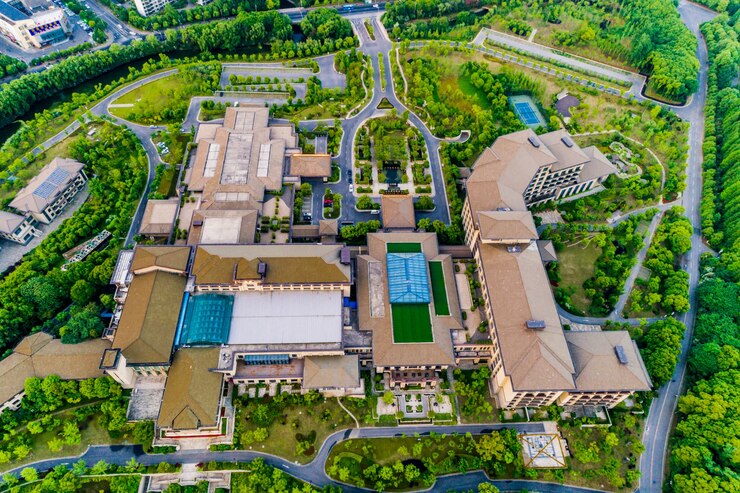In recent decades, urban planners, developers, and municipalities around the globe have increasingly embraced mixed-use development as a transformative approach to city building.
No longer is the rigid separation of residential, commercial, and institutional uses considered optimal; instead, mixed-use developments integrate multiple functions, housing, retail, offices, civic space, and recreation into a coherent, walkable environment.
As metropolitan regions face pressures of densification, infrastructure constraints, and a growing demand for vibrant, 24/7 neighborhoods, mixed-use developments offer a promising solution. By combining uses and fostering interaction across domains, these projects can catalyze economic vitality, reduce car dependency, and build stronger social fabrics. In this article, we’ll explore the defining concepts, benefits and challenges, design typologies, and future trajectory of mixed-use development, while weaving in strategic considerations for investors and civic leaders alike.
What Is a Mixed-Use Development? Understanding the Concept
A mixed-use development is a real estate or urban planning project that intentionally blends two or more compatible uses, typically residential, commercial, cultural, institutional, or entertainment, within a single building, block, or district. Rather than isolating functions in monopurpose zones (e.g., a pure “residential zone” or “office park”), mixed-use developments aim to interweave daily life, work, and leisure.
Key features of mixed-use developments often include:
- Spatial proximity of uses (e.g., ground-floor retail beneath apartments)
- Shared circulation infrastructure (pedestrian paths, transit linkages)
- Coordinated design and management to optimize synergies
- A mix of tenure types (ownership, rental, affordable housing) and varying scales
The concept is not entirely new; historic European cities often evolved this way, but its resurgence in modern urban planning owes much to the desire for more efficient land use, environmental sustainability, and dynamic urban experience.
For developers, municipal leaders, and stakeholders interested in realizing mixed-use projects, especially in burgeoning markets like Texas, strategic partners offering land development services in San Antonio, Houston, and Austin can provide expertise in site acquisition, entitlement, master planning, infrastructure, and implementation. Their regional insight and connections ensure that mixed-use visions become tangible, realizable developments.
The Key Components of Mixed-Use Spaces
A truly successful mixed-use development is more than just a jumble of functions. It relies on deliberate integration, synergy, and quality in design and management. Below are the core components that make mixed-use spaces work.
1. Functional Mix & Compatibility
You must choose uses that complement, not compete with, each other. For instance, retail and dining encourage foot traffic, which benefits residential and office users. A hospital or medical clinic might dovetail with wellness businesses. The mix needs both diversity and compatibility.
2. Physical Integration & Connectivity
The layout should promote permeability, pedestrian pathways, shared lobbies, courtyards, and vertical connections like atriums or galleries. People should be able to move easily between uses without encountering barriers. Also, parking, loading, and back-of-house services must be carefully coordinated so as not to disrupt active street fronts.
3. Shared Infrastructure & Services
Mixed-use developments often benefit from economies of scale: centralized HVAC, waste management, security, maintenance, and utility distribution. Shared amenities, gyms, common lounges, and public plazas can be jointly used by residents, office workers, and visitors.
4. Phasing & Flexibility
Because mixed-use projects tend to be larger and more complex, phasing is essential. Early phases might focus on anchor uses (retail, offices) to generate traffic, followed by residential or hotel. Also, future flexibility is a key design criterion; spaces should be adaptable (for instance, allowing a retail unit to convert to a coworking space).
5. Governance & Management
A master plan or condominium association must manage diverse stakeholders. Leasing, operations, security, maintenance, and rules across uses must be coordinated. Governance structures that balance interests across residential, commercial, and public domain elements are essential.
6. Financing & Capital Structure
Since different uses have distinct cash flow profiles (e.g., retail vs. apartments), financing often involves blended sources: equity investors, commercial lenders, public incentives, tax increment financing, or land leases. The capital model must reconcile and allocate returns across uses.
7. Placemaking & Public Realm
To generate the vibrancy that defines great mixed-use places, attention to architecture, landscaping, activation, and programming (events, street life) is crucial. Public spaces, plazas, pedestrian promenades, and green corridors tie the components together and give the development its identity.
Types of Mixed-Use Developments: Vertical vs. Horizontal Design
Mixed-use developments can take on different spatial forms. At a high level, one can distinguish vertical and horizontal models:
Vertical Mixed-Use
In vertical mixed-use, different uses are stacked within the same structure or high-rise. For example, a building might contain retail or restaurants on the ground and second floors, offices in mid-levels, and apartments or condominiums above. Vertical integration maximizes land efficiency in dense urban cores, provides direct interaction between uses, and reduces walking distance.
Advantages:
- Efficient land utilization in downtown or transit-oriented sites
- Economies of shared structure and utilities
- Strong synergies across uses (e.g., office worker café usage, retail serving residents)
Challenges:
- Structural and acoustic separation between uses
- Fire, mechanical, and service zoning complexities
- Requiring distinct vertical circulation (elevators, stairs, fire egress)
Horizontal Mixed-Use
In horizontal mixed-use, different uses are placed side by side, across blocks or linked via pedestrian streets or courtyards. For example, a development might group townhouses, low-rise apartments, retail shops, restaurants, and offices within a single campus or neighborhood block structure. Horizontal models are more common in suburban or greenfield settings.
Advantages:
- Easier separation of use-specific building systems
- Simpler phasing and expansion
- A more human-scale environment, especially if low to mid-rise
Challenges:
- Requires more land area
- Potential for greater walking distances
- Need for careful integration to avoid isolated or underused zones
Often, large developments use a hybrid approach, multiple mid-rise towers connected by horizontal podiums, shared courtyards, and interlocking blocks. In practice, most modern mixed-use master plans blend vertical and horizontal elements to suit the context.
Iconic Examples of Successful Mixed-Use Developments Worldwide
To illustrate how theory becomes reality, below are selected exemplary projects that showcase the scope and diversity of Mixed-Use Developments.
1. Battery Park City, New York, USA
This large-scale redevelopment on Manhattan’s waterfront blends residential towers, offices, cultural institutions, parks, and retail. It demonstrates how master planning, phased delivery, and strong public domain infrastructure can yield a cohesive mixed-use district.
2. Beijing’s Wangjing SOHO, China
Designed by Zaha Hadid Architects, this sculptural complex integrates offices, retail, and cultural space in a sweeping architectural form. Its fluid circulation and skybridges emphasize vertical connectivity and mixed usage.
3. Canary Wharf, London, UK
Originally a purely commercial enclave, Canary Wharf has evolved into a full mixed‐use district with residential towers, hotels, retail malls, and cultural venues, layered over transit connections. Its transformation illustrates how over time a single‐use hub can diversify.
4. Raffles City, Singapore
A signature example of vertical mixed use: retail podium, offices, residences, hotel, and observation deck stacked across multiple towers and sky bridges. Its integrated design and transit connectivity showcase a compact, vibrant node.
5. Barangaroo, Sydney, Australia
Redeveloped from industrial port land, Barangaroo is a waterfront mixed‐use precinct with commercial towers, residential high rises, public green spaces, dining, and cultural institutions. The project emphasizes ecological rehabilitation and public realm integration.
6. The Pearl District, Portland, Oregon, USA
This former warehouse area has been transformed into a walkable mixed‐use neighborhood, with loft apartments, galleries, shops, parks, offices, and streetcar connectivity. It demonstrates adaptive reuse alongside new infill development.
These examples show that mixed-use developments can adapt to context, from dense downtown cores to waterfront reclamation sites, and can evolve over decades.
7. Pearl District (Historic Pearl Brewery Redevelopment), San Antonio, USA — with Pape-Dawson
A 22–23-acre adaptive reuse of a historic brewery into a mixed-use “village” along the San Antonio River’s Museum Reach, featuring housing (e.g., the 211-unit Can Plant & Townhomes), offices, culinary and market venues, plazas, educational uses, and the boutique Hotel Emma.
Recognized with major urbanism honors (including a ULI Global Award of Excellence), the project showcases phased delivery, placemaking, and sustainability. Pape-Dawson provided civil engineering and mixed-use development services within the district (notably for the Can Plant & Townhomes), working alongside design collaborators to integrate infrastructure with an active public realm.
Why Mixed-Use Spaces Are the Blueprint for Urban Growth
Throughout this article, we have unpacked what Mixed-Use Developments are, their critical components, design typologies (vertical vs. horizontal), benefits and challenges, the role of sustainability, standout global precedents, and their transformational influence on future urban form.
In a world of limited land, constrained infrastructure budgets, climate pressure, and evolving patterns of work and lifestyle, mixed-use development offers a resilient, adaptable, and human-centric model. It allows cities to densify intelligently, create vibrant neighborhoods, optimize resource use, and deliver diversified returns for both communities and investors.




